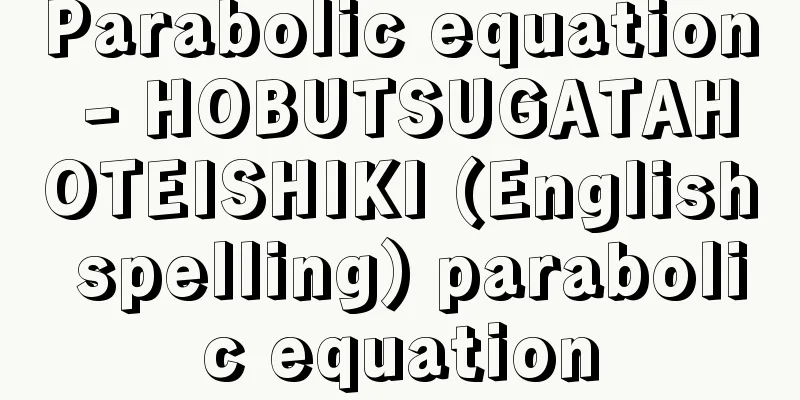Pollution-related disease

|
In a broad sense, it can refer to all diseases caused by pollution, but it usually refers to diseases designated in the law that provides relief to people whose health has been damaged by pollution (Pollution-Related Health Damage Compensation Act). In 1964 (Showa 39), it was discovered that the high incidence of asthma-like respiratory diseases (Yokkaichi asthma) in Yokkaichi City was caused by air pollution, and the city authorities began providing relief to patients with pollution-related diseases. This was the trigger for the term to be popularized by journalism. Pollution-related diseases are characterized by the unique conditions of Japan, a country with a small land area and few natural resources, and an overcrowded and saturated population. The Pollution-Related Health Damage Compensation Law (Law No. 111 of 1973) covers damage related to health damage caused by significant air pollution or water pollution (including deterioration of bottom sediment) over a considerable area that occurs as a result of business activities or other human activities, and classifies health damage caused by pollution into two categories: non-specific diseases caused by general air pollution, and specific diseases caused by air pollution or water pollution due to specific pollutants. The former are designated as Type 1 areas and the latter as Type 2 areas, and the designated areas and diseases are determined by government ordinance. In type 1 areas, diseases include chronic bronchitis, bronchial asthma, asthmatic bronchitis, and emphysema, while in type 2 areas, diseases include Minamata disease (coast of Minamata Bay, downstream of the Agano River), Itai-itai disease (downstream of the Jinzu River), and chronic arsenic poisoning (Sasagatani, Tsuwano town, Shimane prefecture, Toroku, Takachiho town, Miyazaki prefecture). The most difficult problem with pollution-related illnesses is the issue of certification. In other words, if a clear causal relationship could be proven between pollutants or pollution phenomena and the illness or its symptoms and findings, there would be no problem, but in reality, it is extremely difficult to prove because many complex factors are involved. This can lead to differences in judgment even among experts, and in particular, when the interests and concerns of the people involved differ, they can reach completely opposing opinions, which can cause various social disputes. The Central Pollution Control Council (now the Central Environment Council) of the Environment Agency (now the Ministry of the Environment) announced its views on this issue in an interim report by the Medical Subcommittee of the Pollution Damage Compensation Guarantee System Advisory Committee, titled "On the Basic Issues of the Pollution Damage Compensation Guarantee System, Primarily Seen from a Medical Perspective." An excerpt from the report is summarized below. [Sadayoshi Shigeta] Basic concepts of causation
(2) When an association between a specific disease in a certain population and environmental pollution to which that population has been exposed or is exposed has been proven by epidemiological methods, and when this is combined with other medical findings to determine that there is a tentative causal relationship, it is essential to have an institutional arrangement under which it will be deemed that there is a causal relationship with respect to individuals in that population who are suffering from the specific disease, unless there are special circumstances which negate the relationship between the disease of the individuals and the environmental pollution. [Sadayoshi Shigeta] Illness CertificationFor air pollution-related diseases, which are called non-specific diseases, it is extremely difficult to clarify the causal relationship between the disease and air pollutants for each patient, so area designation and exposure requirements have been introduced as a systemic arrangement for determining that there is a causal relationship between air pollution and health damage related to each designated disease, and these requirements will be determined based on air pollution surveys, epidemiological surveys, and medical findings. For specific diseases, in principle, it is desirable to judge the relationship between the disease and the causative substance for each patient. In other words, for diseases related to non-specific air pollution, it is almost impossible to prove a strict causal relationship for each individual, so for first-class air polluted areas where a causal relationship is legally determined to exist for a population based on the results of epidemiological surveys, an arrangement has been made to consider that there is a legal causal relationship if the requirements for the exposure period are met. In other words, if the three conditions of designated area, exposure requirements, and designated disease are met, there is a legal causal relationship between air pollution and each patient. In order to designate an area, it is necessary that there is a certain level of air pollution and that there is a high incidence of diseases caused by the pollution, and the designation is based on the evaluation of air pollution data over many years and the results of a survey on the incidence of chronic bronchitis. Specific diseases are generally considered to not occur in the absence of a particular substance. Therefore, pollutants and diseases that have a specific relationship with them are designated based on scientific research, and areas where those diseases are prevalent are designated as Type 2 areas. Specific diseases are recognized based on proof of exposure to specific pollutants and a medical diagnosis of individuals suffering from that specific disease. [Sadayoshi Shigeta] Certification and compensationIn prefectures or cities designated by government ordinance that have designated areas, a Pollution Health Damage Certification Review Board consisting of up to 15 members with academic knowledge and experience in medicine, law, or other fields related to compensation for pollution-related health damage is established, and the governor or mayor makes certification after hearing the opinion of this review board. The review board reviews applications submitted by patients, which are accompanied by a diagnosis from the patient's doctor stating that the patient has a designated disease. Certification involves two things: a medical certification as to whether or not the patient has a designated disease, and a certification of eligibility to receive compensation benefits such as damage compensation benefits and survivor compensation benefits. In addition to properly checking conditions related to certification, such as the duration of exposure, required functional tests and clinical tests are often conducted. [Sadayoshi Shigeta] "Kido Kenji (ed.), "Pollution-Related Health Damage Compensation Law" (1975, Gyosei)" ▽ "Environment Agency Planning and Coordination Bureau, Environmental Health Department, Health Affairs Division (ed.), "Pollution Medical Handbook" (1976, Weekly Japan Medical News)" [Reference items] | | | by pollution| | | |Source: Shogakukan Encyclopedia Nipponica About Encyclopedia Nipponica Information | Legend |
|
広義には公害が原因でおこるすべての疾病をさす場合もあるが、普通は公害によって健康上の被害を受けた人々を救済する法律(公害健康被害補償法)に指定されている疾病をいう。1964年(昭和39)四日市市の喘息(ぜんそく)様呼吸器疾患(四日市喘息)の多発が大気汚染によるものであることが判明し、市当局が公害病として患者の救済を開始したことを契機とし、ジャーナリズムによって広められた日本独特の用語である。天然資源の乏しい狭い国土に過密的飽和人口を抱える日本固有の条件を背景にしていることが、公害病の特徴である。 公害健康被害補償法(昭和48年法律111号)では、事業活動そのほか人の活動に伴って生ずる相当範囲にわたる著しい大気の汚染、または水の汚濁(水底の底質が悪化することも含む)の影響による健康被害にかかわる損害をその対象としており、汚染の影響による健康被害を、一般的な大気汚染による非特異的な疾病と、特定の汚染物質による大気汚染や水質汚濁の影響による特異的疾病の二つに分類し、前者を第一種地域、後者を第二種地域として、それぞれ政令により指定地域と指定疾病を決めている。第一種地域では慢性気管支炎、気管支ぜん息、ぜん息性気管支炎、肺気腫(はいきしゅ)など、第二種地域では水俣(みなまた)病(水俣湾沿岸、阿賀野(あがの)川下流)、イタイイタイ病(神通(じんづう)川下流)、慢性ヒ素中毒症(島根県津和野町笹ヶ谷(ささがたに)、宮崎県高千穂町土呂久(とろく))などである。 公害病でもっともむずかしいのは認定問題である。すなわち、汚染物質や汚染現象と病気やその症状および所見の間にはっきりした因果関係が証明されれば問題ないが、実際には多くの複雑な要素が加わるために、立証することがきわめて困難である。このため専門家の間にも判断の相違がみられたり、とくに関係者の利害や関心が異なるとまったく相反する意見となることもあり、社会的にさまざまな紛争を生じる原因となる。この問題について環境庁(現環境省)の中央公害対策審議会(現中央環境審議会)では、公害損害賠償保証制度諮問委員会医療分科会の「主として医学の立場からみた公害損害賠償保証制度の基本問題について」と題する中間報告で見解を発表した。その要旨の抜粋を次にまとめた。 [重田定義] 因果関係についての基本的な考え方
(2)ある人口集団の特定の疾病とその人口集団が暴露されたか、また暴露されている環境汚染との間に疫学的手法によって関連性が証明され、これにさらに他の医学的知見を加えていちおう因果関係があると判断された場合、その人口集団のなかの当該特定疾病にかかっている個人については、その個人の疾病と環境汚染との関係を否定する特別の事情がない限り、因果関係があるものとみなすことを制度上の取決めとすることが不可欠である。 [重田定義] 疾病の認定非特異的疾患といわれる大気汚染系疾病については、疾病と大気汚染物質との因果関係を個々の患者について明らかにすることはきわめて困難であるので、個々の指定疾病にかかわる健康被害者について、大気汚染との間に因果関係があるとみなす制度上の取決めとして、地域指定および暴露要件を導入することとし、これらの要件は、大気汚染調査、疫学調査、医学的所見を基礎として定めるものとする。特異的疾患については、原則的には疾病と原因物質との関係を個々の患者について判断することが望ましい。つまり、非特異的な大気汚染にかかわる疾患では、多くの場合個々に厳密な因果関係の証明を行うことはまず不可能なので、疫学調査結果に基づき、人口集団について因果関係があると法的に判断される第一種の大気汚染地域については、暴露期間についての要件を満たしていれば法的に因果関係があるとみなすという取決めをしている。すなわち、指定地域、暴露要件、指定疾病の三つの条件を満たせば、個々の患者について大気汚染と法的因果関係があるというわけである。 地域の指定に際しては、一定以上の大気汚染が生じており、かつその影響による疾病が多発していることが必要であり、長年月にわたる大気汚染データの評価と慢性気管支炎の有症率調査結果を基礎としている。特異的疾患については、一般にその物質がなければその疾病はおこりえないという考え方にたっている。そこで、汚染物質と、それと特異的な関係にある疾病を科学的な調査研究に基づいて指定しており、その疾病の多発している地域を第二種地域として指定している。特異的疾患の認定にあたっては、特定の汚染物質に対する暴露の事実の証明と、その特定の疾患にかかっている個人についての医学的診断に基づいて行われている。 [重田定義] 認定と補償給付について指定地域のある都道府県または政令で定める市には、医学や法律学そのほか公害健康被害の補償に関する学識経験を有する15名以内の委員によって構成される公害健康被害認定審査会が設置され、知事または市長がこの審査会の意見を聞いて認定を行う。審査会は、患者から、指定疾病にかかっていることを示す主治医の診断書を添えた認定申請を受けて審査を行う。認定には、指定疾病であるか否かという医学的認定と、被害補償給付や遺族補償給付など補償給付の受給資格に関する認定の二つがある。認定に関連して暴露期間などについての条件を適正に確認することのほかに、所要の機能検査や臨床検査を行う場合が多い。 [重田定義] 『城戸謙次編『公害健康被害補償法』(1975・ぎょうせい)』▽『環境庁企画調整局環境保健部保健業務課編『公害医療ハンドブック』(1976・週刊日本医事新報社)』 [参照項目] | | | | | | |出典 小学館 日本大百科全書(ニッポニカ)日本大百科全書(ニッポニカ)について 情報 | 凡例 |
<<: Bipalium - Bipalium (English spelling)
>>: Pollution crime - kougaihanzai
Recommend
Aristolochia clematitis
…[Ichiro Sakanashi]. … *Some of the terminology t...
Pagurus dubius (English spelling)
…Hermit Crab [Masamichi Takeda]. . . *Some of the...
Social psychology
It refers to everyday emotions, moods, fantasies, ...
Hiradokoro Haniwa Kiln Site - Hiradokoro Haniwa Kiln Site
It is located in Hirasho, Yatamachi, Matsue City, ...
d'Arras, J.
...When the lord of Lusignan castle was to be rep...
Arvid Järnefelt
1861‐1932 Finnish author. He corresponded with Tol...
Logos (Greek)
One of the basic words in ancient Greek philosoph...
Kansk-Achinsk (English spelling)
…Coal reserves in Siberia provide fuel for most o...
Price formation - Kakaku Keisei (English spelling) pricing
[Price formation by private companies] The main p...
lupulin
...The shape, size, and number of cones vary depe...
Iris [town] - Shobu
An old town in Minami Saitama County, in the centr...
Hideyoshi Satake
Year of death: 12/18/1226 (1/17/1226) Year of birt...
Nagatomo Kayano
1873-1947 A continental ronin from the Meiji to e...
Hatake
Hague is a type of eczema that appears as round, w...
Atrax robustus (English spelling)
...The components of the venom are unknown. The m...









